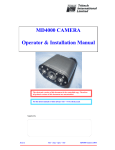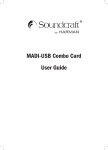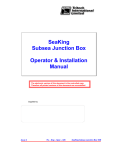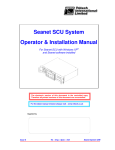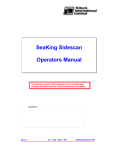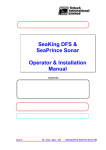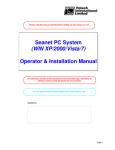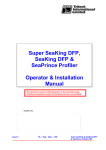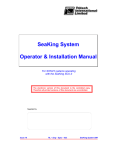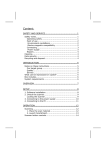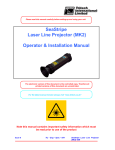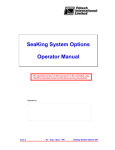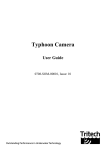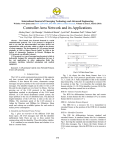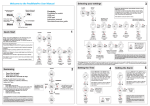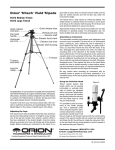Download SeaKing SPLIT AIF Card Fibre Optic Interface Operator
Transcript
SeaKing SPLIT AIF Card Fibre Optic Interface Operator & Installation Manual (SONV3 Software V1.50 and later) The electronic version of this document is the controlled copy. Therefore all printed versions of this document are uncontrolled. Supplied by: Issue 3 TIL – Eng – Spec – 025 SeaKing Split AIF Card OIM COPYRIGHT © Tritech International Ltd The copyright in this document is the property of Tritech International Limited. The document is supplied by Tritech International Limited on the understanding that it may not be copied, used, or disclosed to others except as authorised in writing by Tritech International Limited. Tritech International Limited reserved the right to change, modify and update designs and specifications as part of their ongoing product development programme. F063.1 Tritech International Ltd SeaKing Split AIF Card (Fibre Optic I/F) OIM TABLE OF CONTENTS Handling of Electrostatic-Sensitive Devices ......................................................................................... 5 Technical Support .................................................................................................................................. 7 SEAKING SPLIT AIF CARD INTRODUCTION.............................................................................. 8 OPERATIONAL OVERVIEW ............................................................................................................ 8 SECTION A:........................................................................................................................................... 9 BENCH TEST SETUP FOR SPLIT AIF CARD .................................................................................. 9 SECTION B: ......................................................................................................................................... 11 INSTALLING SPLIT AIF FOR RS-232 COMMUNICATIONS ........................................................... 11 PART 1: SURFACE HARDWARE INSTALLATION.............................................................................. 11 PART 2: SUBSEA HARDWARE INSTALLATION ................................................................................ 12 SECTION C:......................................................................................................................................... 14 SOFTWARE SETUP FOR RS-232 OPERATION............................................................................. 14 SECTION D:......................................................................................................................................... 16 PART 1: USING AIFV4 FOR ARCNET OPERATION ................................................................... 16 PART 2: SOFTWARE SETUP FOR ARCNET OPERATION ......................................................... 17 PART 3: ARCNET BAUD RATE CHANGES ON AIFV4 CARD ................................................... 18 Issue 3 TIL – Eng – Spec – 025 Page 4 of 18 Tritech International Ltd SeaKing Split AIF Card (Fibre Optic I/F) OIM Handling of Electrostatic-Sensitive Devices Attention Observe Precautions for handling Electrostatic Devices Caution Handling of Electrostatic-Sensitive Devices Certain semiconductor devices used in the equipment are liable to damage due to static voltages. Observe the following precautions when handling these devices in their unterminated state, or sub-units containing these devices: • Persons removing sub-units from any equipment using electrostatic sensitive devices must be earthed by a wrist strap via a 1MΩ resistor to a suitable discharge reference point within the equipment. • Soldering irons used during any repairs must be low voltage types with earthed tips and isolated from the Mains voltage by a double insulated transformer. Care should be taken soldering any point that may have a charge stored. • Outer clothing worn must be unable to generate static charges. • Printed Circuit Boards (PCBs) fitted with electrostatic sensitive devices must be stored and transported in appropriate anti-static bags/containers. F110.0 Issue 3 TIL – Eng – Spec – 025 Page 5 of 18 Tritech International Ltd SeaKing Split AIF Card (Fibre Optic I/F) OIM Warranty Statement Tritech International Limited herein after referred to as TIL TIL warrants that at the time of shipment all products shall be free from defects in material and workmanship and suitable for the purpose specified in the product literature. The unit/system warranty commences immediately from the date of customer acceptance and runs for a period of 365 days. Customer acceptance will always be deemed to have occurred within 72 hours of delivery. Note: Any customer acceptance testing (if applicable) must be performed at either TIL premises or at one of their approved distributors unless mutually agreed in writing prior to despatch. Conditions: These include, but are not limited to, the following: 1 The warranty is only deemed to be valid if the equipment was sold through TIL or one of its approved distributors. 2 The equipment must have been installed and commissioned in strict accordance with approved technical standards and specifications and for the purpose that the system was designed. 3 The warranty is not transferable, except or as applies to Purchaser first then to client. 4 TIL must be notified immediately (in writing) of any suspected defect and if advised by TIL, the equipment subject to the defect shall be returned by the customer to TIL, via a suitable mode of transportation and shall be freight paid. 5 The warranty does not apply to defects that have been caused by failure to follow the recommended installation or maintenance procedures. Or defects resulting from normal wear & tear, incorrect operation, fire, water ingress, lightning damage or fluctuations in vehicles supply voltages, or from any other circumstances that may arise after delivery that is outwith the control of TIL. (Note: The warranty does not apply in the event where a defect has been caused by isolation incompatibilities.) 6 The warranty does not cover the transportation of personnel and per diem allowances relating to any repair or replacement. 7 The warranty does not cover any direct, indirect, punitive, special consequential damages or any damages whatsoever arising out of or connected with misuse of this product. 8 Any equipment or parts returned under warranty provisions will be returned to the customer freight prepaid by TIL 9 The warranty shall become invalid if the customer attempts to repair or modify the equipment without appropriate written authority being first received from TIL. 10 TIL retains the sole right to accept or reject any warranty claim. 11 Each product is carefully examined and checked before it is shipped. It should therefore be visually and operationally checked as soon as it is received. If it is damaged in anyway, a claim should be filed with the courier and TIL notified of the damage. Note: TIL reserve the right to change specifications at any time without notice and without any obligation to incorporate new features in instruments previously sold. Note: If the instrument is not covered by warranty, or if it is determined that the fault is caused by misuse, repair will be billed to the customer, and an estimate submitted for customer approval before the commencement of repairs. F167.1 Issue 3 TIL – Eng – Spec – 025 Page 6 of 18 Tritech International Ltd SeaKing Split AIF Card (Fibre Optic I/F) OIM Technical Support Contact your local agent or Tritech International Ltd Mail Tritech International Ltd. Peregrine Road, Westhill Business Park, Westhill, Aberdeen, AB32 6JL, UK Telephone ++44 (0)1224 744111 Fax ++44 (0)1224 741771 Email [email protected] Web www.tritech.co.uk An out-of-hours emergency number is available by calling the above telephone number If you have cause to use our Technical Support service, please ensure that you have the following details at hand prior to calling: • • • System Serial Number ( if applicable ) Fault Description Any remedial action implemented Due to the expansion of equipment capabilities and the fact that new sub-modules are continually being introduced, this manual cannot detail every aspect of the operation. Issue 3 TIL – Eng – Spec – 025 Page 7 of 18 Tritech International Ltd SeaKing Split AIF Card (Fibre Optic I/F) OIM SEAKING SPLIT AIF CARD INTRODUCTION The Split AIF system is required when it is necessary to use a fibre optic system for communications between the control unit and the subsea sensors. This may be because a twisted pair is not available or if the cable length is too long to support the high speed data link over conventional conductors (typically in excess of 1.5km) This manual must be used in conjunction with other system manuals supplied with the system. The Split AIF Fibre Optic interface consists of two boards’ one inside the SCU (AIFV4) and one board on the subsea end of the fibre optic system (SA AIF). Note: The older style AIFBV3 card can be used when upgrading an existing system. Definitions: SA AIF AIFV4 Stand Alone Acoustic Interface – Locates in the dry pod subsea. Acoustic Interface Version 4 – Locates inside the Surface Control Unit. (The AIFBV3 card can be used as a direct replacement if Software version 1.50 or above is used) OPERATIONAL OVERVIEW The Split AIF Interface can be utilised in two ways. 1. By making use of both AIFV4 and SA AIF cards, the system can be configured for RS232 communications between cards (for interface to an RS232 fibre optic MUX) and then ARCNET between the subsea card and multiple heads. SONAR/PROFILER HEAD SEAKING SCU RS-232 FIBRE OPTIC SA AIF CARD AIF V4 CARD SURFACE COMMUNICATIONS CARD ARCNET FIBRE-OPTIC TX/RX SUBSEA COMMUNICATIONS CARD 2. Diagram 1.01: General Layout for RS232 operation. Issue 3 TIL – Eng – Spec – 025 Page 8 of 18 Tritech International Ltd SeaKing Split AIF Card (Fibre Optic I/F) OIM 3. Using only the surface AIFV4 card, the system can be configured for ARCNET and will run multiple heads through a single copper twisted pair of up to 2500 metres in length. Diagram 1.02: General Layout for ARCNET operation (Using AIFV4 only) SEAKING SCU ARCNET: Useable through twisted pair up to 2.5km in length SONAR/PROFILER HEAD AIF V4 CARD SURFACE COMMUNICATIONS CARD SECTION A: BENCH TEST SETUP FOR SPLIT AIF CARD In order to set up the Split AIF RS-232 communications it is important that the following procedure is followed closely as failure to do so may result in permanent communication loss to the SA AIF. To initially configure and test the Split AIF system it is advisable to first set the system up on a bench, connecting the SA AIF PCB directly to the AIFV4 card. 1) For powering the SA AIF PCB, a power supply cable has been included and this will connect to the +12 V DC supply output (banana plug sockets) situated on the rear of the SCU. 2) RS-232 I/O on both the AIFV4 and SA AIF cards is on their respective AUX-IDC ports. For interconnection, wire a short NULL modem RS-232 cable, as follows: AIFV4 – AUX-IDC (9-way M ‘D’) SA AIF – AUX-IDC (9-way M ‘D’) 2--------------------------------------------------3 3--------------------------------------------------2 5--------------------------------------------------5 1 1 2 2 AIFV4 'J8' SA AIF 'J4' RS232 links • IDC wiring pin-outs Issue 3 TIL – Eng – Spec – 025 Page 9 of 18 Tritech International Ltd SeaKing Split AIF Card (Fibre Optic I/F) OIM The full bench wired configuration is as follows; SEAKING SCU 68 ohm termination i t ARCNET-A <Head pin-1> J8 (AUX-IDC) ARCNET-B <Head pin-2> 1 J6 J5 1 1 +12 to 24VDC 4 GND J4 (AUX-IDC) 1 SA AIF Card AIFV4 Card 'J2.3' 9-way M 'D' Null Modem 9-way F 'D' RS-232 9-way F 'D' 9-way M 'D' ARCNET-A 1 2 ARCNET-B 'J6' Diagram 1.03: Bench Wiring Refer to Section C of this manual for software configuration, including selection of RS-232 Baud rates. Issue 3 TIL – Eng – Spec – 025 Page 10 of 18 Tritech International Ltd SeaKing Split AIF Card (Fibre Optic I/F) OIM SECTION B: INSTALLING SPLIT AIF FOR RS-232 COMMUNICATIONS PART 1: SURFACE HARDWARE INSTALLATION The surface AIFV4 card is fitted inside the SeaKing SCU (Surface Control Unit) or PC in the case of a PC Kit. The existing AIFV3 card can be used if an upgrade package is supplied. Inside the SCU, the ribbon cable from the RAT connects to J9 (RAT-IDC). The ribbon cable from the 10-way COM2 header on the motherboard connects to J11 (RATCOM-PIN) or to J10 (RATCOM-IDC) in unique cases. When fitting to a PC, the J9 header is not used. Using the RAT Extension lead supplied with the SCU, the RAT can also connect to J5 which is the 9-way ‘D’ type port on the backplane of the card. A SCU backplane plate with 9-way ‘D’ male and ribbon connector is supplied with the system. This fits inside the SCU in an adjacent slot to the AIFV4 card and is J2.3 on the SCU. The ribbon cable from this plate plugs into J8 (AUX-IDC) on the AIFV4 card*. RS-232 communications to the Fibre Optic MUX is now made through J2.3.(see diagram 1.04). Pin-outs are as below: J2.3 – 9D Male pin allocations 2 ----------------------------------- RS-232 Uplink data. (Yellow) 3 ----------------------------------- RS-232 Downlink data. (Blue) 5 ----------------------------------- RS-232 Ground. (Screen) ARCNET output Connector RAT Extension Connector J2.2 J2.1 Expansion Slots Slot 7 Sonar AIFV4 Card J2.3 RS232 output from AIFV4 Card Slot 6 May be used for PORT 2 & PORT3 Slot 5 Slot 4 J3.1 VGA Card Slot 3 J1.1 PORT 1 Slot 2 Multi IO Card Can be used to bench power SA AIF Optional 12V for video O/P Slot 1 J5 J1 J2 SCU3BCK2 Diagram 1.04: Rear view of SCU with AIFV4 Fitted Issue 3 TIL – Eng – Spec – 025 Page 11 of 18 Tritech International Ltd SeaKing Split AIF Card (Fibre Optic I/F) OIM PART 2: SUBSEA HARDWARE INSTALLATION The subsea SA AIF PCB should be fitted as near as possible to the subsea FO MUX. This card has one power connector; J5. A mating connector is supplied and +12 to +24 Volts DC (max) must be applied. There are three data connectors; J3, J4, J6 (J3 is unused). Two ribbon connectors are supplied, one 9-way D male and one 15-D female. The 9-way ribbon connects to J4 (AUX IDC) this is used for RS-232 communications to the Fibre Optic MUX. See diagrams 1.03 & 1.11 for exact pin-outs. The 15-way ribbon connects to J6 (LAN-IDC) this is used for ARCNET communications to the SeaKing sensors. See diagram 1.11. The 15-way ‘D’ pin-outs are exactly the same as for J3 on the original Tritech AIFBV3 card (see the main SeaKing system manual). However, ONLY pins 8 and 15 (ARCNET) on the 15-way ‘D’ should be connected on the SA AIF output. A termination resistor is required and should be a single 68 ohms when the ARCNET circuit is less than 100metres in length. SA AIF CARD - 'SW1' ON 1 2 Switch 1: ON = Normal * OFF = Boot Switch 2: OFF= Normal Baud ON = Half Baud * factory setting - do not touch Switches CPU J3 J3 Not Connected 9-way ‘D’ J4 J5 Pin 4 J6 Pin8 – ARCNET-A (to Heads Pin 1) Pin15 – ARCNET-B (to Heads Pin 2) Fit a single 68ohm resistor anywhere between ARCNET-A and ARCNET-B. This will terminate the entire ARCNET circuit. Gnd Diagram 1.11: "Split AIF" subsea card (SA AIF) power and data connections Issue 3 To Subsea Fibre Optic Mux 15-way ‘D’ Pin 1 +12 to 24 VDC Pin3 - RS232 Uplink (Blu) Pin2 - RS232 Downlink (Yel) Pin5 - RS232 Ground (Scrn) TIL – Eng – Spec – 025 Page 12 of 18 Tritech International Ltd SeaKing Split AIF Card (Fibre Optic I/F) OIM 118mm 6.5mm 3mm Diameter holes J3 7mm 105mm 114.6mm J4 J6 127.5mm Diagram 1.12: "Split AIF" subsea card (SA AIF) dimensions. Issue 3 TIL – Eng – Spec – 025 Page 13 of 18 Tritech International Ltd SeaKing Split AIF Card (Fibre Optic I/F) OIM SECTION C: SOFTWARE SETUP FOR RS-232 OPERATION (Software version 1.50 and above) Use BENCH TEST SETUP FOR SPLIT AIF CARD described previously Switch on the power to the SCU and this will also supply +12 VDC to the SA AIF card. Close the SONV3 software and load V3Setup by clicking on it’s Windows Program Icon. The following Table will appear: IF NODE 254 DOES NOT APPEAR ESTABLISH COMMUNICATIONS USING (RECOVERY) 9600 BAUD SPEED, as below Press the Program User Data button. The AIF SETUP panel appears as below: Uncheck the Aif V4 Hi Speed check box. Press Exit and Program on request. Once the program is complete shut down V3setup. Switch off power to the SA AIF and set it’s ‘SW1’ Switch-2 to ON position. Switch power to the SA AIF back on. Restart V3SETUP and press Rebuild. The SA AIF card should now appear as NODE 254 using the (recovery) RS-232 communications rate of 9600 baud. Issue 3 TIL – Eng – Spec – 025 Page 14 of 18 Tritech International Ltd SeaKing Split AIF Card (Fibre Optic I/F) OIM SETTING FIBRE LINK SPEED Step 1: Subsea Interface – SA AIF Select Node 254 Press Program User Data button, then Baud rates The following panel appears: Locate the settings for Async 0 channel and set right-hand baud rate to desired Fibre link speed (default speed is 115.2 kBaud*). * speeds less than 38.4k are unadvisable for imaging sonar applications Press Exit and Program Node 254 when prompted. SETTING FIBRE LINK SPEED Step 2: Surface Interface – AIFV4 Select Node 255 Press the Program User data button again, then press Baud rates. The following panel appears Locate the settings for Async 0 channel and set right-hand baud rate to desired Fibre link speed. This should match the SA AIF link speed setting (default speed is 115.2 kBaud*). * speeds less than 38.4k are unadvisable for imaging sonar applications. Press Exit and check AIF V4 Hi Speed check box, if unchecked. Press Exit and Program Node 255 when prompted. Switch off power to the SA AIF and set it’s ‘SW1’ Switch-2 to OFF. Switch power back on. Restart V3SETUP and press Rebuild. NODES 255 & 254 should now appear. The RS-232 link is now running at the Async 0 right-hand Baud speed (as shown in the above panel) and the Split AIF system is now ready to be integrated with the Fibre Optic system as per the Hardware Installation described previously. Issue 3 TIL – Eng – Spec – 025 Page 15 of 18 Tritech International Ltd SeaKing Split AIF Card (Fibre Optic I/F) OIM SECTION D: PART 1: USING AIFV4 FOR ARCNET OPERATION HARDWARE INSTALLATION The Hardware installation is the same as for the standard AIFBV3 card. The ARCNET output is now from pins 8 and 15 on the AIFV4 card’s J2.1 connector (See diagram 1.21 & 1.22) TERMINATION ARCNET impedance termination is 270 ohms at the surface and 39ohms subsea (i.e. Standard SeaKing ARCNET resistor values) WARNING: The AIF mating connector may be supplied fitted with a lower value resistor intended for use with the Split AIF RS232 configuration, this must be checked and changed if incorrect. Termination: surface : 270 ohms subsea : 39 ohms J2.2 AIF V4 Card Pin 8 : ARCNET A (To heads pin 1) J2.1 Pin 15 : ARCNET B (To heads pin 2) Diagram 1.21: AIFV4 ARCNET Connections. Issue 3 TIL – Eng – Spec – 025 Page 16 of 18 Tritech International Ltd SeaKing Split AIF Card (Fibre Optic I/F) OIM ARCNET output Connector RAT Extension Connector J2.2 J2.1 Expansion Slots Slot 7 Sonar AIFV4 Card J2.3 RS232 I/O from AIFV4 Card Slot 6 May be used for PORT 2 & PORT3 Slot 5 Slot 4 J3.1 VGA Card Slot 3 J1.1 PORT 1 Multi IO Card Can be used to bench power SA AIF Slot 2 Slot 1 Optional 12V for video O/P J5 J1 J2 SCU3BCK2 Diagram 1.22: Rear view of SCU showing AIFV4 ARCNET connection J2.1 PART 2: SOFTWARE SETUP FOR ARCNET OPERATION (Software version 1.50 and above) The AIFV4 card operates under ARCNET exactly the same as the AIFBV3 card, with an exception that is detailed on Part 3. The card is capable of communicating through J2.3 to the SA AIF card AND through J2.1 directly to heads using ARCNET SIMULTANEOUSLY. Therefore there is no further software settings required to operate a network directly through twisted pair. Issue 3 TIL – Eng – Spec – 025 Page 17 of 18 Tritech International Ltd SeaKing Split AIF Card (Fibre Optic I/F) OIM PART 3: ARCNET BAUD RATE CHANGES ON AIFV4 CARD I) On an AIFBV3 card there is a hardware switch to select between half baud (78kb) and Full baud (156kb). II) On the AIFV4 card this is done in software as follows. Run V3SETUP Press Program V4 AIF This will bring up the following panel: The Aif V4 Hi Speed check box replaces the hardware switch. With the box checked the system will run at 156 kbit/s. With the box unchecked the comms will be 78 kbit/s. Issue 3 TIL – Eng – Spec – 025 Page 18 of 18


















